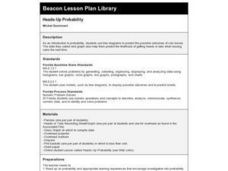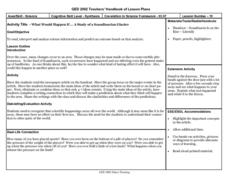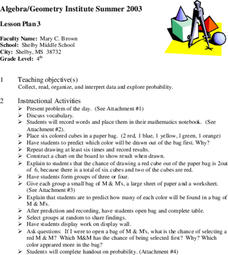Curated OER
Heads-Up Probability
Second graders use tree diagrams to predict the possible outcomes of coin tosses. The data they collect and graph also help them predict the likelihood of getting heads or tails when tossing coins the next time.
Curated OER
What Are the Risks?
Students use dice to determine the risk of being exposed to radon. They practice using new vocabulary related to probability and ratios. They make predictions about the results and record their observations.
Curated OER
The Mysterious Tadpole
Second graders examine books written by Steven Kellogg, looking for similarities in his illustrations. They also look at images found on the Internet. They listen to a read aloud of The Mysterious Tadpole up to the point where the eggs...
Curated OER
Memories, A Connection to the Past
Third graders read four books related to the past and memories. With a partner, they complete a graphic organizer for each story in English or Spanish. To end the lesson plan, they write a short paper summarizing the material and...
Curated OER
What Would Happen If ... A Study of a Scandinavian Glacier
Young scholars read an article about changes is the landforms in Scandinavia. They identify the main ideas. They eliminate or combine to make 4-7 main ideas. Finally students write about what they predict happen share, and discuss.
Curated OER
Exploring Probability
Fourth graders participate in a lesson that explores probability. They use candy and model cubes to experiment with different outcomes that can be charted if the students can proceed to the objective of the lesson. They discover how...
Curated OER
Kissing Coyotes
Fourth graders are read the book "Kissing Coyotes". During the story, they make predictions about what they believe might happen next. After the story, they create their own story using their imagination and draw illustrations.
Curated OER
Calendar & Weather Book
Second graders track weather patterns through the school year. They take daily readings and record them in a weather book.
Curated OER
Just a Minute
Students recognize the importance of maintaining a healthy body in order to participate in a physical activity for one to five minutes.
Curated OER
Seven Fat Cats
First graders listen to a read aloud of "Seven Fat Cats" matching rhyming, beginning, ending and vowel sounds.
Curated OER
Past v. Present: Using Geography & Anthropology
Students examine artifacts and documents from their Canadian community. They analyze early Canadian history and make predictions about the future of the country.
Curated OER
Find a Book
Student receives one book description card and in less than 2 minutes, they walk through the Media Center to find a book matching that description. After a matching book is found, each student evaluates the book.
Curated OER
Evaluating an Olympic Sport
Learners research the political context of the Winter Olympics in general and within certain countries in particular. They read authentic, published articles on the topic from the Internet and add this information to the spreadsheet as...
Curated OER
The Artist As Entrepreneur: VARA-visual Artists Rights Act
Learners read case studies of artists' lawsuits under the Visual Artists Rights Act and then discuss the merits of fictitious cases where artists might consider a lawsuit. They predict the outcome of a lawsuit scenario and justify their...
Curated OER
Germany Rejects Spanish ‘Transfer Bid’ for Octopus
Tenth graders explore the importance of Paul the octopus. In this World Cup lesson plan, 10th graders research the location of Germany and its cities on a map. Students read an article and answer questions.
Curated OER
A Tacky Cheer
Second graders make predictions, copy cheers, and make inferences as they read a story about an odd bird and his awkward attempts to help his fellow penguins win a cheering contest.
Curated OER
What Does Waste Do to a River?
Students develop a graphic way of visualizing the concept of a million by utilizing what had happened to the Nashua River due to the dumping of raw sewage in 1962.
Curated OER
Beep, Beep, Vroom, Vroom
Students practice identifying, creating and labeling simple patterns. They recreate patterns in used in Stuart Murphy's book, Beep, Beep, Vroom, Vroom.
Curated OER
Mathematics: Best Salary
Sixth graders pretend to need jobs to earn money for a go-cart which costs $1,000. They predict which of two scenarios raise the money first. they construct charts and graphs to demonstrate their predictions.
Curated OER
Tony's Spelling Troubles
Students are introduced to the given problem and describe in their own words the situation represented in a bar chart and tally chart. They then use a bar chart and tally chart to make sensible predictions.
Curated OER
Alphabet Study
Fifth graders predict what they believe the five most common letters are in the English language. After sharing their predictions in a group, they develop a new list of the most common letters used. Using a book, they count the number...
Curated OER
Nature of Meteor Showers
Ninth graders describe, in general terms, the distribution of matter in space and
identify evidence for, and describe characteristics of, bodies that make up the solar system. They then investigate predictions about the motion,...
Curated OER
Living Longer
Students practice strategies that can be applied to current and future reading materials. Using a matrix, students monitor which strategies they have mastered and which strategy needs more practice. Students read health related materials.

























